Kazimierz is one of the most authentic and surprising districts of Krakow. What was the old Jewish Quarter until the tragic events of WWII it has transformed into one of the liveliest and most enchanting parts of the city. Filled with charming restaurants, cozy pubs, bustling local markets, and remnants of a tragically turbulent past, Kazimierz offers a truly unique experience.
Following the war Kazimierz was left in a state of decay, but its revival began with the filming of Schindler’s List and now the district has become one of the most desirable areas in Krakow, attracting residents, diners, and nightlife enthusiasts, particularly students. Within the lively streets of Kazimierz, one can discover a genuine and authentic atmosphere. The district exudes an undeniable charm, with its narrow alleys and quaint establishments beckoning visitors to explore its hidden treasures, solemn synagogues and poignant memorials. Amidst the historical backdrop, Kazimierz has embraced modernity while preserving its authentic character.
The district has become a vibrant cultural center and the lively pubs pulsate with energy, inviting visitors to experience the lively nightlife. Within Kazimierz, Jewish culture is experiencing a remarkable resurgence: art galleries, kosher restaurants, and klezmer concerts are thriving, enriching the neighborhood day by day. This cultural boom adds a vibrant and dynamic dimension to Kazimierz, attracting both locals and tourists who are eager to immerse themselves in this fascinating heritage.
Whether you are strolling through its charming streets, indulging in delectable cuisine, exploring the local markets, or partaking in the cultural offerings, Kazimierz is undoubtedly one of the musts in a visit to Krakow.
What you will find in this guide to Kazimierz:
- Some interesting facts to know about Kazimierz
- Things to Do and See in Kazimierz
- What is the best way to visit Kazimierz and the Jewish Quarter
- How to get to Kazimierz from Krakow’s Old Town
Some interesting facts to know about Kazimierz
Kazimierz is a district located just south of Krakow’s Old Town, reachable within a few minutes’ walk from Wawel Hill. Kazimierz and Krakow were once two different towns, and each had its own defensive walls and autonomy.
Kazimierz stood on an ancient island, surrounded by the Vistula River. At the beginning of the 19th century, as the cities had merged together, and Kazimierz had become just a district of Krakow, part of the river was filled with soil and a boulevard was built in its place.
Kazimierz’s history dates back to 1335, when King Casimir III the Great decided to found a new city on the outskirts of Krakow. The city bears his name, and at the time its inhabitants enjoyed the same privileges as those of the royal city, Krakow.
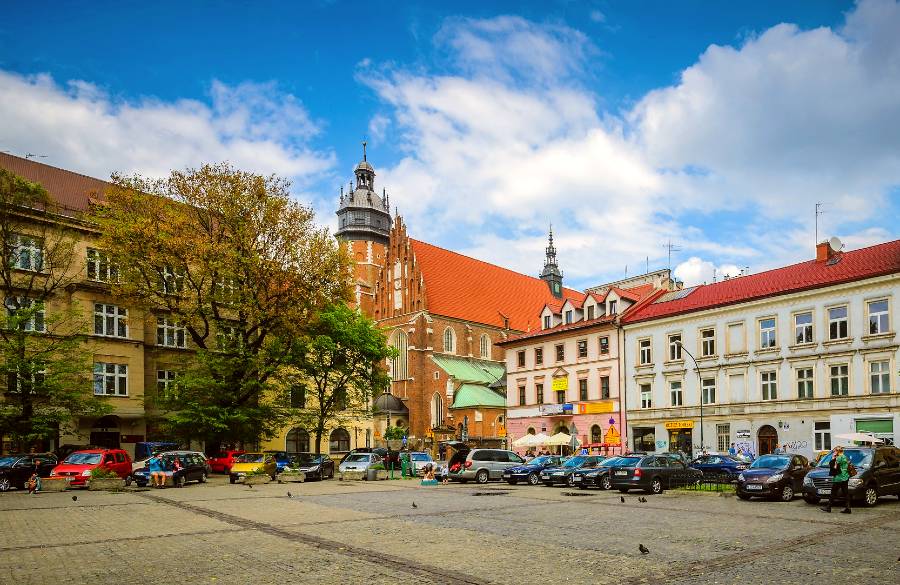
In 1494 a devastating fire destroyed Krakow, which had to be redesigned and rebuilt. King Jan I Olbracht decided to grant it to the large and important Krakow Jewish community in the Bawół district of Kazimierz. Here the Jews had the right to build their own town protected by a defensive wall, living peacefully with the Polish community that inhabited the remaining half of Kazimierz.
This area of Kazimierz, called Oppidum Judaeorum, became one of the major centers of Polish Judaism, inhabited by some of the best Jewish scientists, writers, artists and craftsmen.
Under the Austrian Emperor Joseph II, the city of Kazimierz was merged with Krakow and the Jewish community merged with the Polish one. There were over 120 synagogues throughout the city, and in the old Oppidum of Kazimierz only the poorest and most ultra-conservative Jews remained. Perhaps that is why we can still see how Kazimierz looked in the 18th century today, as its buildings have remained virtually unchanged.
After the Nazi occupation of Krakow, Jews were expelled from the city and those who decided to stay in 1941 were transferred to the Krakow Ghetto, established in the Podgórze district, across the river from Kazimierz. Tens of thousands of people were forced to live in an area that previously housed a maximum of 2-3,000 inhabitants.
From late 1941 to March 1943 when the Ghetto was liquidated, tens of thousands of Jews were sent to die in concentration camps, such as nearby Płaszów and the extermination camps of Belzec and Auschwitz. A little more than a thousand people survived, mostly thanks to Oscar Schindler, a German industrialist who had hired them to work in his factory.
After the war, the Jewish quarter of Kazimierz became one of the most degraded and infamous places in Krakow. Only in the early 90s did it begin to be revalued, mainly thanks to the popularity given by the film Schindler’s List, which was set and filmed here.
Over the years it has become one of the most popular neighborhoods among artists, students, beatniks and hipsters. In summer, the Jewish Culture Festival in Krakow is held here, one of the most important and interesting in the world. The neighborhood has become one of the liveliest in Krakow, less crowded with tourists than the Old Town and more authentic.
In the streets of Kazimierz you can feel the charm of the old days, taste excellent Polish-Jewish cuisine and have a drink in some of the most original bars in the city. Free walking tours of Kazimierz and the nearby Podgórze Jewish Ghetto take place every day, remember to book in advance.
Things to Do and See in Kazimierz
Although Kazimierz is today one of the major attractions of Krakow, like the Wawel Royal Castle, it is much less crowded with tourists than the streets of the Old Town. It’s a good place for a calm stroll and for a drink or a meal in the evening.
Plac Nowy
The heart of Kazimierz is Plac Nowy, a somewhat shabby-looking square that serves as the perfect place to immerse yourself in the life and culture of the neighborhood. Every day, a local market is held in Plac Nowy where residents come to buy fresh fruit and vegetables. Additionally, a flea market is also hosted here, offering antiques and old Communist memorabilia for those interested in unique finds.
At the center of Plac Nowy stands the round building known as Okrąglak to the locals. This historic structure dates back to 1900 and serves as a covered market. Along its perimeter, several windows allow people to order food. Notably, this is the place to savor some of the best zapiekanka in Krakow.
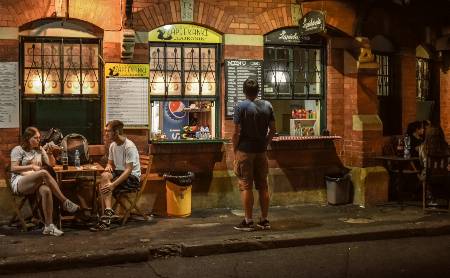
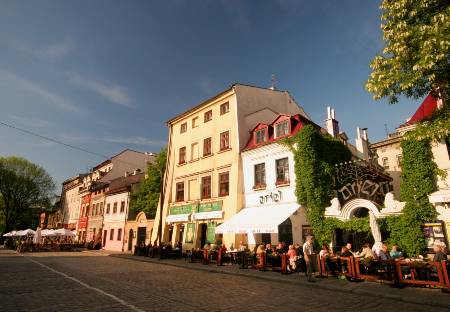
Szeroka Street
Szeroka Street is undoubtedly the most picturesque corner of Kazimierz. Once serving as the main square of the neighborhood until the late 19th century, it was the bustling center of life and commerce for the Jewish community. Today, this former market square has transformed into one of the most vibrant places in Kazimierz, adorned with excellent traditional Polish-Jewish restaurants, bars, and art galleries.
You find yourself at the heart of the Oppidum Judaeorum, the epicenter of Kazimierz, where the original buildings still stand remarkably preserved. Notably, at number 16 stands the Popper Synagogue, one of the oldest and most significant landmarks, though internally devastated by the Nazis, it has since been transformed into a cultural center.
As you stroll through Szeroka Street, make sure to spot The Old Synagogue (Synagoga Stara) at one of the corners. An Orthodox-Jewish synagogue, it dates back to the early 15th century and holds the distinction of being the oldest in both Krakow and Poland. Today, it houses an intriguing museum dedicated to the life and culture of the local Jewish people, and entry is free with the City Pass Krakow Card.
Do not miss the opportunity to visit the small and picturesque Remah Synagogue (Synagoga Remu) at Szeroka number 40, dating back to the 16th century. It stands as one of the four synagogues that remain active in the city, showcasing the rich historical heritage of Kazimierz.
Ancient Synagogues of Kazimierz
Among the most renowned synagogues visible on Szeroka Street, such as the Old Synagogue and the Remah Synagogue, lies the Tempel Synagogue, dating back to 1860 and meticulously restored after World War II. Throughout the war, this very synagogue was tragically transformed into an ammunition depot by the Nazis. Today, it proudly stands as the largest active synagogue in Krakow.
A short distance away, one can explore the Izaak Synagogue, which dates back to the 17th century. This stunning architectural marvel was only recovered after the fall of communism, having been previously used as an art exhibition hall. Tragically, during the war, the Nazis confiscated the synagogue in 1939, and a heart-wrenching event occurred when the Gestapo entered the premises. On that fateful day, the Jewish official on duty bravely resisted their orders to burn the sacred scrolls of the Torah and was fatally shot as a consequence.
Venturing along the path that connects the Tempel Synagogue and the Izaak Synagogue, you will encounter the Kupa Synagogue, a remarkable structure from the 17th century. Inside, visitors are captivated by the exquisitely adorned interiors featuring intricately carved wood and stucco decorations.
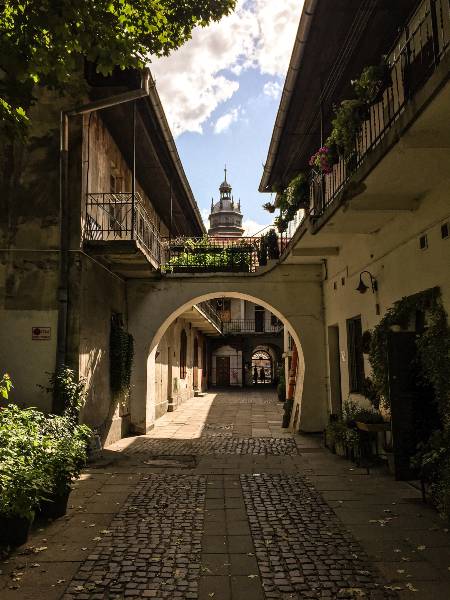
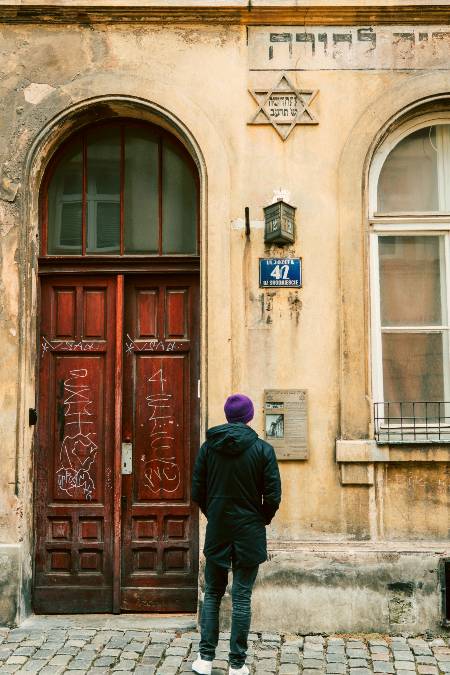
Jewish Ghetto of Krakow
Combining a visit to Kazimierz with the Krakow Ghetto makes a lot of sense. The Ghetto is located in the Podgórze district, just across the river. To reach the Ghetto, you can cross one of the bridges over the Vistula: the most popular are the Piłsudski Bridge, an authentic iron bridge dating back to the 1930s and rebuilt after the war, and the Father Bernatek’s Bridge, a modern bridge inaugurated in 2010.
Once you arrive, head to the heart of the ghetto, Plac Bohaterów Getta (Ghetto Heroes Square), where deportations to concentration camps took place. From there, you can continue your journey to Schindler’s Factory, one of the most significant places for understanding the history of the Krakow Ghetto.
For the best experience, consider taking a guided tour of Kazimierz and the Jewish Ghetto. The area holds many significant places and stories to explore, and having a local expert guide you through it will enhance your understanding. If you opt for the most comprehensive tour, you’ll also have the opportunity to visit the Płaszów Concentration Camp and Schindler’s Factory.
Corpus Christi Basilica
As mentioned earlier, Kazimierz was a neighborhood where Jews and Poles (Christians) coexisted peacefully. Therefore, it comes as no surprise that in Kazimierz you can find some of the most beautiful churches in Krakow.
One such magnificent example is the Corpus Christi Basilica, a majestic Gothic church founded by King Casimir III the Great in 1335. Upon entering, you will be greeted by stunning Baroque elements crafted in carved wood and the largest organ in Krakow.
Church on the Rock (Kościół na Skałce)
Located a bit off the beaten path, the Church on the Rock is undeniably one of the most significant landmarks in Krakow. Originally, this site housed one of the most important sanctuaries in the area, constructed in the 14th century only to be destroyed by the Swedes in the 17th century.
The present-day monastery was rebuilt in 1734 in the elegant Baroque style and is devoted to St. Michael the Archangel and St. Stanislaus, the revered bishop of Krakow and martyr. As one of the most important sanctuaries in the region, it holds immense significance for the local community.
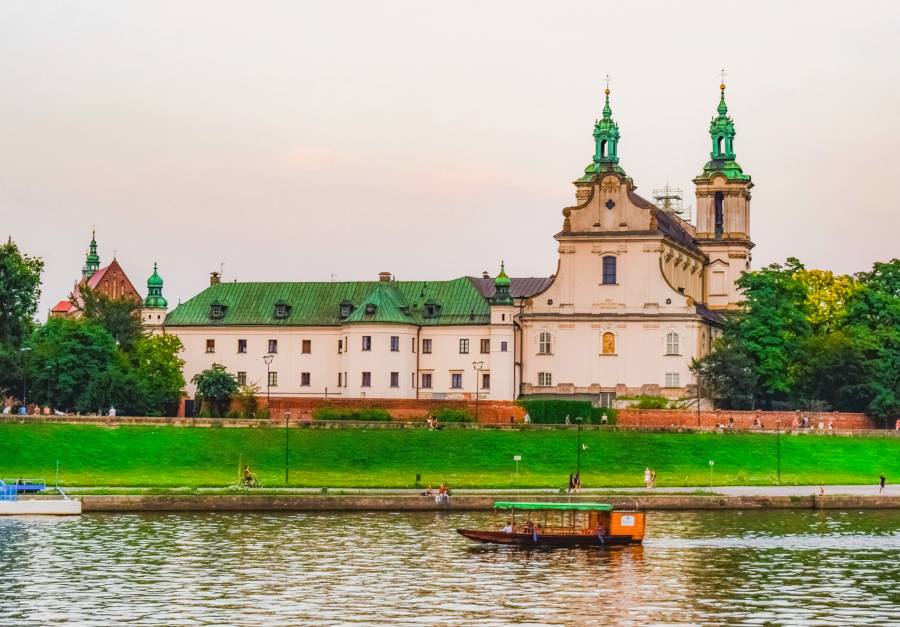
Galicia Jewish Museum
The Galicia Jewish Museum is a permanent cultural center dedicated to preserving the rich history and culture of the Galician Jewish community. Through its captivating photographic exhibits, the museum offers a profound insight into life in the Jewish district before the Nazi occupation, as well as during the most tragic phases of the massacre and the period after the war.
Admission to the museum is free with the City Pass Krakow Card, allowing visitors to explore this significant cultural site and all the most important museums in Krakow without any additional cost.
Museum of Municipal Engineering
The Museum of Municipal Engineering is a delightful destination, particularly if you are traveling with kids or have a passion for technical exhibits. Situated within an old tram depot dating back to the late 19th century, this museum houses a fascinating collection of vintage Polish cars, old city trams (occasionally seen running on the streets of Kazimierz during weekends), and other artifacts from the city’s past. It is not very big, so you can visit it in less than an hour.
One of the best parts is that entry is free with the City Pass Krakow Card, making it an even more appealing attraction to visit. Consider paying a visit to this charming museum to delve into the historical wonders of municipal engineering while enjoying a memorable experience, especially if you’re accompanied by kids or have a keen interest in technical history.
What is the best way to visit Kazimierz and the Jewish Quarter
Kazimierz can easily be explored on foot. Steeped in history, it boasts a plethora of historic buildings, each with its own captivating story and legend. The remnants of the ancient Jewish Quarter lend an aura of mystique, while the lively gathering spots draw in locals and visitors alike.
To ensure you make the most of your visit, consider joining one of the free daily walking tours, where a knowledgeable local guide will lead you through the neighborhood’s hidden gems. Remember to book in advance to secure your spot!
☞ Read our guide to the Best Free Tours in Krakow
For a more enriching experience, consider combining your visit to Kazimierz with a cultural exploration of the Krakow Ghetto. There are affordable guided tours offering deeper insights into the ghetto’s history and an opportunity to visit Schindler’s Factory.
History enthusiasts will find immense value in an in-depth tour, led by an expert guide. This comprehensive journey includes a visit to the Płaszów Concentration Camp and Schindler’s Factory, providing a profound understanding of the area’s historical significance.
How to get to Kazimierz from Krakow’s Old Town
From Krakow Old Town, you can easily reach Kazimierz with a pleasant 15-minute walk. From the foot of Wawel Hill, at the end of Grodzka (the boulevard that starts from the Main Market Square), follow Stradomska Street towards the Vistula and you will arrive in Kazimierz.
Once on Stradomska Street, you can continue your exploration by taking Józefa Street, which will lead you to the heart of Kazimierz. Don’t miss the opportunity to visit the famous Schindler’s List Passage at no. 12, one of the locations featured in Spielberg’s film.
If you prefer public transportation, the closest tram stops are Stradom (served by trams 8, 10, 13) and Miodowa (served by trams 3, 19, 24), which is on the opposite side of Kazimierz, near Szeroka Street. For added convenience, if you have the City Pass Krakow Card, you can enjoy free rides on trams and buses.
☞ Read our guide to the City Pass Krakow Card
Hotels in Kazimierz and Surroundings: Stay in the Vibrant Heart of Krakow
Kazimierz stands as one of the liveliest cultural hubs of the city and is renowned for its vibrant nightlife. The area boasts numerous charming local bars highly favored by the locals, along with a wide array of excellent restaurants. So why not consider staying in Kazimierz? From here, you can conveniently reach the attractions of the Old Town while enjoying a more intimate and relaxed atmosphere.
Discover the best Hotels in Kazimierz, or if you’re seeking other high-quality options, take a look at our guide to the best 5-Star Hotels in Krakow. Alternatively, if you’re traveling on a budget, our guide to the top Hostels in Krakow might come in handy.
Things to Do and See Around Kazimierz
Kazimierz is conveniently located within easy reach of the Podgorze district, the former Krakow Ghetto, where you can explore remnants of the city’s turbulent past and visit the famous Schindler’s Factory Museum.
A short walk from Kazimierz will take you to the heart of Krakow’s Old Town, where you’ll find a plethora of main attractions to explore. Be sure to check out our must-read list of the Best Things to Do and See in Krakow.
Planning your trip to Krakow? Then these will come in handy: